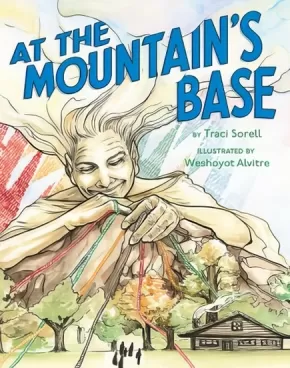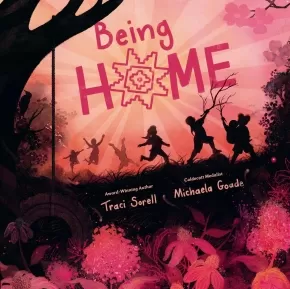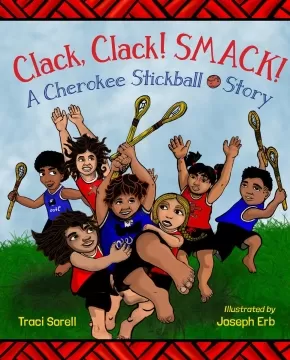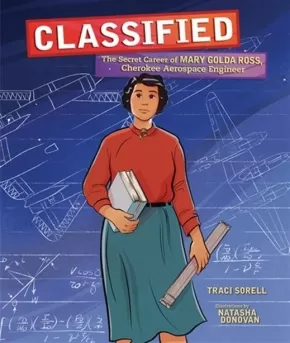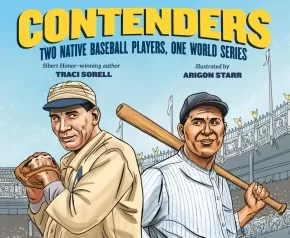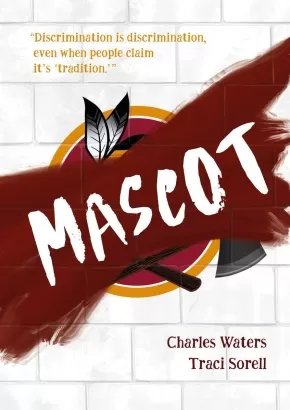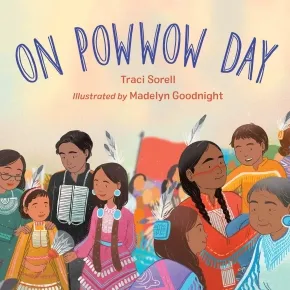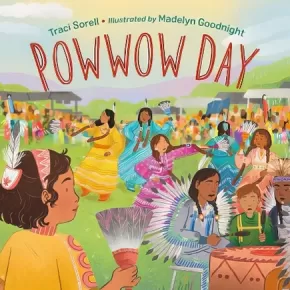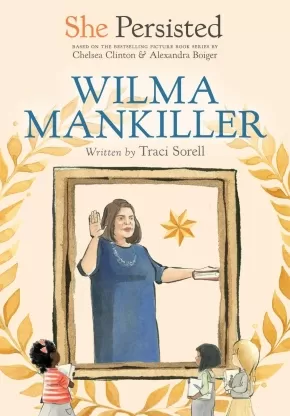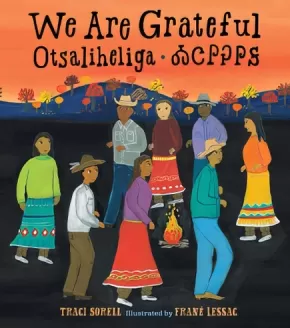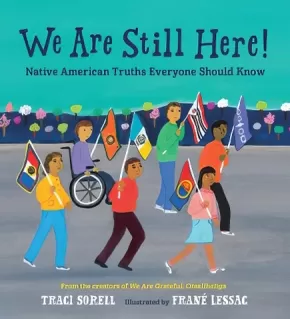
Traci Sorell
Traci Sorell writes fiction and nonfiction for children featuring contemporary characters and compelling biographies. She is an enrolled citizen of the Cherokee Nation and lives in northeastern Oklahoma, where her tribe is located.
Kids Books (11)
At the Mountain's Base
$25.99
Artists:
Format: Hardcover
Text Content Territories:
Indigenous American; Native American; Cherokee;
ISBN / Barcode: 9780735230606
Synopsis:
Synopsis:
A family, separated by duty and distance, waits for a loved one to return home in this lyrical picture book celebrating the bonds of a Cherokee family and the bravery of history-making women pilots.
At the mountain's base sits a cabin under an old hickory tree. And in that cabin lives a family -- loving, weaving, cooking, and singing. The strength in their song sustains them through trials on the ground and in the sky, as they wait for their loved one, a pilot, to return from war.
With an author's note that pays homage to the true history of Native American U.S. service members like WWII pilot Ola Mildred "Millie" Rexroat, this is a story that reveals the roots that ground us, the dreams that help us soar, and the people and traditions that hold us up.
Additional Information
32 pages | 9.38" x 11.81"
Being Home
$24.99
Artists:
Format: Hardcover
Text Content Territories:
Indigenous American; Native American; Cherokee;
ISBN / Barcode: 9781984816030
Synopsis:
Synopsis:
From Sibert Honor–winning author Traci Sorell and Caldecott Medal–winning artist Michaela Goade comes a heartwarming picture book about a Native American family and the joy of moving back to their ancestral land.
Today is a day of excitement—it’s time to move! As a young Cherokee girl says goodbye to the swing, the house, and the city she's called home her whole life, she readies herself for the upcoming road trip. While her mother drives, the girl draws the changing landscape outside her window. She looks forward to the end of the journey, where she'll eat the feast her family has prepared, play in the creek with her cousins, and settle into the new rhythm of home.
With warm, expressive artwork and spare, lyrical prose, the story of a young girl’s move toward rather than away from home unfolds.
Reviews
"An evocative, heartwarming testament to the power of home and community." —Kirkus Reviews, starred review
"It’s a joyful image of a family embracing change that examines “the rhythm of being home." —Publishers Weekly starred review
Educator Information
Recommended for ages 4 to 8.
Additional Information
32 pages | 10.00" x 10.00" | Hardcover
Clack, Clack! Smack! A Cherokee Stickball Story
$21.99
Artists:
Format: Hardcover
Text Content Territories:
Indigenous American; Native American; Cherokee; Cherokee Nation (Cherokee Nation of Oklahoma);
ISBN / Barcode: 9781623541934
Synopsis:
Synopsis:
Vann, a struggling stickball player, competes in a game on the Cherokee Nation. Can he help his team win? Written by award-winning Cherokee author Traci Sorell.
Vann loves playing his tribe’s stickball game, but he’s not as skilled as his teammates. Vann stumbles, and he tries and fails to score. How can he help his teammates win?
Exciting and fast-paced, Clack, Clack! Smack! reminds readers that sportsmanship and being a team player is just as important as being the star. Back matter explains the origins of Cherokee stickball.
Reviews
"Two Cherokee teams play a game of stickball in Tahlequah, Oklahoma. Vann feels insecure about having missed a key shot in last week’s match. “Stickball requires speed,” after all, and his “towering body” won’t cooperate. As Vann and his team, the Eagles, take to the field against the Redhawks, they “zip,” “chase,” and “rush” for the ball, their wooden sticks clashing with a “CLACK, CLACK!” Coach gives the team a pep talk in Tsalagi, the Cherokee language. He reminds them of gadugi, the importance of working together. As the players return to the field to finish the game, Vann’s best friend, Jesse, gives him an encouraging smile. The game is now tied. Can Vann and his team win? Sorell and Erb, both members of the Cherokee Nation, deliver an uplifting story of team spirit and collaboration; the emphasis is on group triumphs rather than individual victories. Writing in terse, alliterative prose—“a tackle, a twist, and a wrong turn”—Sorell skillfully builds tension as she choreographs this action-packed game. Erb’s thick-lined cartoon illustrations have a pleasing solidity; they capture the chaos and drama of the game and depict players with a range of brown skin tones. The story features frequent Tsalagi words and phrases. Backmatter stresses the importance of keeping the Cherokee language alive and explains the significance of stickball, which traditionally was used to settle conflicts. Stand and cheer for this fast-paced tale of sportsmanship and community." —Kirkus Reviews
Educator Information
Recommended for ages 4 to 7.
Additional Information
32 pages | 8.38" x 10.31" | Hardcover
Classified: The Secret Career of Mary Golda Ross, Cherokee Aerospace Engineer
$30.50
Artists:
Format: Hardcover
Text Content Territories:
Indigenous American; Native American; Cherokee;
ISBN / Barcode: 9781541579149
Synopsis:
Synopsis:
Mary Golda Ross designed classified airplanes and spacecraft as Lockheed Aircraft Corporation's first female engineer. Find out how her passion for math and the Cherokee values she was raised with shaped her life and work.
Cherokee author Traci Sorell and Métis illustrator Natasha Donovan trace Ross's journey from being the only girl in a high school math class to becoming a teacher to pursuing an engineering degree, joining the top-secret Skunk Works division of Lockheed, and being a mentor for Native Americans and young women interested in engineering. In addition, the narrative highlights Cherokee values including education, working cooperatively, remaining humble, and helping ensure equal opportunity and education for all.
Awards
- 2021 Junior Library Guild Selection winner
- 2021 Eureka! Children's Book Award Winner
- 2021 A Mighty Girl's Book fo the Year winner
- 2022 Rise: A Feminist Book Project List winner
- 2022 Cooperative Children's Book Centre Choices winner
Reviews
"Highlights the life and secret work of Cherokee aerospace engineer Mary Golda Ross.
As a teen in the 1920s, Mary Golda Ross loves 'puzzling out math equations' despite expectations of the times. At 16, she finds being the only girl in a college math class means working extra hard to prove herself to the boys who 'refused to sit next to' her. Guided by her Cherokee belief that 'gaining life skills in all areas' is important, Ross not only strives for better grades, she aims for loftier goals. Each step of the way—whether teaching high school, working for the Bureau of Indian Affairs, or helping solve aircraft design flaws during World War II— Ross is fueled by other Cherokee principles as well. Ultimately, her passion for math and her commitment to those deeply rooted values result in her selection to a 'supersecret work team' that promises to take her career, and the world, farther than ever before. Meticulously researched and subtly framed according to the Cherokee beliefs that piloted Ross, page-turning prose elevates this Indigenous hidden figure to her rightful place in history. In addition, bold, classic-comics–like illustrations and colors reminiscent of 1950s advertisements give an appropriately retro vibe. A stellar addition to the genre that will launch careers and inspire for generations, it deserves space alongside stories of other world leaders and innovators.
Liftoff. A biography that lands beyond the stars!"—starred, Kirkus Reviews
"Mary Golda Ross, born to Cherokee Nation–citizen parents, always excelled at math. Graduating from high school at 16 and college at 20, she became a math and science teacher. When WWII began, she was hired by Lockheed Aircraft, where she worked with engineers correcting a design flaw in P-381 fighter planes. Later, she was chosen as the only female in Lockheed's Skunk Works group (a top-secret program whose efforts are still mostly classified), designing spacecraft for NASA. Sorell's (Indian No More, 2019) succinct text emphasizes Ross' reliance on Cherokee values (gaining skills, working cooperatively, remaining humble, and ensuring equal opportunity for all), which played a defining role in her successes and influenced the mentoring work she chose in her retirement. Donovan's illustrations employ rich earth-tone colors and bold outlines, and often incorporate sequential storytelling techniques, enabling multiple scenes to appear in one spread. Appended with a time line, author's note, and resources, this biography makes a valuable addition to units on Indigenous individuals or women in STEM."—Booklist
Educator Information
Recommended for ages 7 to 11.
Lexile 940
Guided Reading Level: R
Keywords / Subjects: Narrative Nonfiction, Diverse Books, Feminism, #OwnVoices, Race & Ethnicity, Social Justice, Diversity, STEM, Space Science
Additional Information
32 pages | 9.25" x 11.00"
Contenders: Two Native Baseball Players, One World Series
$26.99
Artists:
Format: Hardcover
Text Content Territories:
Indigenous American; Native American; Anishinaabeg; Ojibwe (Chippewa); Minnesota Chippewa Tribe; White Earth Band of Ojibwe; Cahuilla;
ISBN / Barcode: 9780593406472
Synopsis:
Synopsis:
The true story of John Meyers and Charles Bender, who in 1911 became the first two Native pro baseball players to face off in a World Series, teaches important lessons about resilience, doing what you love in the face of injustice, and the fight for Native American representation in sports.
Charles Bender grew up on the White Earth Reservation in Northwestern Minnesota. John Meyers was raised on the Cahuilla reservation in Southern California. Despite their mutual respect for each other's talents and their shared dedication to Native representation in baseball, the media was determined to pit them against each other.
However, they never gave up on their dreams of being pro baseball players and didn’t let the supposed rivalry created by the media or the racism they faced within the stadium stop them. They continued to break barriers and went on to play a combined total of nine championships.
With text by Traci Sorell and illustrations by Arigon Starr that brings these two players to life, the stories of John Meyers and Charles Bender remain an inspiration for achieving and maintaining one’s dreams in the face of prejudice.
Educator Information
Recommended for ages 6 to 9.
Additional Information
48 pages | 11.30" x 9.30" | Hardcover
Mascot
$21.99
Format: Hardcover
Text Content Territories:
Indigenous American; Native American; Cherokee;
ISBN / Barcode: 9781623543808
Synopsis:
Synopsis:
What if a school's mascot is seen as racist, but not by everyone? In this compelling middle-grade novel in verse, two best-selling BIPOC authors tackle this hot-button issue.
Six kids. One mascot. Who wins?
In Rye, Virginia, just outside Washington, DC, people work hard, kids go to school, and football is big on Friday nights. An eighth-grade English teacher creates an assignment for her class to debate whether Rye’s mascot should stay or change. Now six middle schoolers–-all with different backgrounds and beliefs–-get involved in the contentious issue that already has the suburb turned upside down with everyone choosing sides and arguments getting ugly.
Told from several perspectives, readers see how each student comes to new understandings about identity, tradition, and what it means to stand up for real change.
Reviews
"Waters and Sorell (Cherokee Nation) join forces to write about the power of being true to oneself.
In a middle school in Rye, a fictional town near Washington, D.C., a racist mural and offensive pep rally chants shock new student Callie Crossland, who is a citizen of the Cherokee Nation and African American. Callie shares a heartfelt poem with her seventh grade honors English class, reminding everyone that the “stupid tomahawk-chop chant” and the “cheap chicken-feather headdress” are nothing less than symbols of “white supremacy.” Afterward, Ms. Williams, her teacher, assigns a persuasive writing and oration project entitled “Pros and Cons of Indigenous Peoples as Mascots.” The small, broadly diverse group of students is assigned to work in pairs; Callie is matched with Franklin, who is Black and a proud fan of the Rye Braves football team. Franklin insists, “I wish we could Lysol racism away. / It’s a bad odor,” but he feels conflicted: “I still don’t think our mascot is racist though. It brings so much joy. / …what’s the big deal?” This clever novel unfolds in poems told in multiple voices showing the wide range of students’, families’, and community responses to the controversy; for some, initial feelings of opposition, hesitation, or indifference change and friendships are tested. The compelling, highly relevant subject matter and accessible text invite readers to understand different perspectives and witness individual growth.
A brilliant story not to be missed; deeply engaging from the first page. (glossary, additional information and resources) (Verse fiction. 10-14)" —Kirkus Reviews, starred review
"Told via seven alternating narratives, this ripped-from-the-headlines collaboration in verse by Waters (African Town) and Cherokee Nation member Sorrel (One Land, Many Nations) follows a fictional town’s division over a racist sports mascot. Callie Crossland, who is Cherokee and Black, has just transferred to a middle school in Rye, Va. She immediately expresses disgust at her school’s mascot, a “copper-toned, muscled, loincloth-clad, tomahawk-wielding” caricature of an Indigenous person. Callie’s English teacher Ms. Williams soon assigns a group writing project regarding the “Pros and Cons of Indigenous Peoples as Mascots,” and Callie is annoyed at being paired with Black classmate Franklin, who believes the mascot “brings so much joy.” Waters and Sorrel paint a complex portrait of the differing reactions toward the controversy by layering the racially diverse tweens’ perspectives and showcasing the effects the event has on their individual relationships and the community beyond their school. The creators eschew judgment to present a well-rounded discussion about classism and racism, as well as effective allyship, with compassion and understanding. A glossary and resources conclude. Ages 10–up." —Publishers Weekly, starred review
"Ms. Williams tasks her... honors English students with a persuasive writing and oral presentation assignment arguing the pros and cons of using Indige-nous peoples as mascots. Throughout the course of a school year the story unfolds in a series of poems that detail the per-spectives of six students: Callie (Cherokee African), Franklin (African American), Priya (Indian American), Luis (Salvadoran American), Tessa (white and previously homeschooled), and Sean (working-class white). Predictably, Callie, Priya, and Tessa (who sees herself as a committed antiracist) oppose Indigenous mascots, while the boys, who enjoy war paint and tomahawk chops at Rye Braves games, claim the mascot de-picts pride in the team and their school. While the discord around the mascot is a long-standing one in the Virginia community, the assignment empowers the students to take the issue to the school board. After further research, one student switches sides, losing a friend in the process. While the plot requires a fair amount of exposition detailing history and arguments on both sides, the characters are well developed and believable, and the story flows smoothly. A valuable classroom pick that demonstrates the importance of debate." —Booklist
Educator Information
Recommended for ages 10+
Includes a glossary and additional resources / information.
Subjects / Themes: Discrimination, Different Perspectives, Identity, Tradition, Standing up for Change, Social Responsibility, Verse Fiction / Poetry
Additional Information
256 pages | 5.75" x 8.56" | Hardcover
On Powwow Day (BB)
$10.99
Artists:
Format: Board Book
Text Content Territories:
Indigenous American; Native American; Cherokee; Cherokee Nation (Cherokee Nation of Oklahoma);
Grade Levels: Preschool;
ISBN / Barcode: 9781623545765
Synopsis:
Synopsis:
In this board book by best-selling Native author Traci Sorell, discover colors, sounds, and counting from one to ten on powwow day!
This eye-catching, interactive board book is sure to keep toddlers engaged. Count one through ten as you make your way through the day of the powwow, looking for colors, family members, jingle dresses, musical instruments, and tribal citizens in this introduction to a traditional Native event.
An award-winning children's picture book adapted to be ready for little listeners in a warm and vibrant board book edition.
Reviews
"A colorful counting book engages children to identify the different visual elements that occur on powwow day. From the car that vrooms to the shaking shiny jingle cones, the exciting expressions catch more beyond the eye. The rainbow palette is shown off in organic and youthful design work. Every number from one to ten has a corresponding color, attached to a powwow day element. Readers can identify and count these elements, from the gray feathers on regalia to the bright moccasins. VERDICT This delightful picture book allows Indigenous children to connect with and feel pride in the abundance of powwow participation, and gives all readers a great counting book full of cultural imagery."—School Library Journal, starred review
Educator Information
Recommended for ages 3 and under.
Additional Information
20 pages | 5.88" x 5.88" | Board Book
Powwow Day (HC) (9 in Stock)
$21.99
Artists:
Format: Hardcover
Text Content Territories:
Indigenous American; Native American;
ISBN / Barcode: 9781580899482
Synopsis:
Synopsis:
In this uplifting, contemporary Native American story, River is recovering from illness and can't dance at the powwow this year. Will she ever dance again?
River wants so badly to dance at powwow day as she does every year. In this uplifting and contemporary picture book perfect for beginning readers, follow River's journey from feeling isolated after an illness to learning the healing power of community.
Additional information explains the history and functions of powwows, which are commonplace across the United States and Canada and are open to both Native Americans and non-Native visitors.
Awards
- 2023 Wyoming Buckaroo Award
Reviews
"A heartwarming picture book about the roles of courage, culture, and community in the journey of personal healing." —Kirkus Reviews
"A resonant, hopeful tale about the healing power of community and tradition" —Publishers Weekly
Educator Information
Recommended for ages 4 to 8.
Additional Information
32 pages | 9.44" x 9.31" | Hardcover
She Persisted: Wilma Mankiller
$7.99
Format: Paperback
Text Content Territories:
Indigenous American; Native American; Cherokee; Cherokee Nation (Cherokee Nation of Oklahoma);
ISBN / Barcode: 9780593403051
Synopsis:
Synopsis:
The descendant of Cherokee ancestors who had been forced to walk the Trail of Tears, Wilma Mankiller experienced her own forced removal from the land she grew up on as a child. As she got older and learned more about the injustices her people had faced, she dedicated her life to instilling pride in Native heritage and reclaiming Native rights. She went on to become the first woman Principal Chief of the Cherokee Nation.
In this chapter book biography by award-winning author Traci Sorell, readers learn about the amazing life of Wilma Mankiller--and how she persisted.
Complete with an introduction from Chelsea Clinton, black-and-white illustrations throughout, and a list of ways that readers can follow in Wilma Mankiller's footsteps and make a difference!
Educator Information
Recommended for ages 6 to 9.
This book is part of the She Persisted series, a chapter book series about women who spoke up and rose up against the odds.
Additional Information
80 pages | 5.31" x 7.63" | Paperback
We Are Grateful: Otsaliheliga
$21.99
Artists:
Format: Hardcover
Text Content Territories:
Indigenous American; Native American; Cherokee; Cherokee Nation (Cherokee Nation of Oklahoma);
ISBN / Barcode: 9781580897723
Synopsis:
Synopsis:
The Cherokee community is grateful for blessings and challenges that each season brings. This is modern Native American life as told by an enrolled citizen of the Cherokee Nation.
The word otsaliheliga (oh-jah-LEE-hay-lee-gah) is used by members of the Cherokee Nation to express gratitude. Beginning in the fall with the new year and ending in summer, follow a full Cherokee year of celebrations and experiences. Written by a citizen of the Cherokee Nation, this look at one group of Native Americans is appended with a glossary and the complete Cherokee syllabary, originally created by Sequoyah.
Awards
- 2019 Sibert Honor Book
- NPR's Guide to 2018's Great Reads
- Kirkus Reviews Best Books of 2018
- 2018 Book Launch Award (SCBWI)
Reviews
"According to storyteller Sorell, the Cherokee people always express gratitude for the little things they are given by saying the phrase, "Otsaliheliga," or "we are grateful." Raised in the Cherokee Nation, Sorell intentionally crafts a narrative that simultaneously embraces modernity and a traditional presentation of Cherokee community and way of life. Throughout, the measured text reminds readers that in all things "we say otsaliheliga." Colorful, folk art-style illustrations show Cherokee people during ceremonies, in family gatherings large and small, and outdoors enjoying each of the four seasons, always expressing gratitude. The scenes are contemporary; one shows a father taking care of his children, engaging in a positive parenting role, while another depicts a family seeing off a relative who is leaving for deployment in the military, underscoring that Cherokee people serve their country. Children participate in rites and in family outings with adults, and they also play traditional games such as stickball and plant strawberries, a practice that reminds their people to embrace peace with one another. The variety of skin tones represented in the illustrations likewise depicts a present-day reflection of the diversity that exists within the Cherokee people. Occasional Cherokee words are written in Romanized form, phonetically, in Cherokee characters, and in English—a lovely grace note. A gracious, warm, and loving celebration of community and gratitude. —Kirkus Reviews
"An extended family engages with activities and traditions that express gratitude and carry on Cherokee history and culture, such as stomp dancing at the Great New Moon Ceremony, basket weaving, making corn-husk dolls, and playing stickball. The book underscores the importance of traditions and carrying on a Cherokee way of life while simultaneously incorporating modernity and challenging dated media images of Indigenous people. Here, a father sporting an earring and a topknot minds the children; a family bids goodbye to a clan relative who deploys with the U.S. military. Skin colors range from light to dark, visually underscoring the book’s message of diversity and inclusion. Staying firmly upbeat and idyllic, the cheerful, richly detailed gouache illustrations in bright, saturated colors cycle through the seasons, beginning with the Cherokee New Year in autumn. The text includes several Cherokee words; a line of text in a smaller font along the bottom of the page provides each word as written in the English alphabet, its phonetic pronunciation, the word as written in the Cherokee alphabet, and its definition. A glossary, an author’s note on Cherokee culture, and a complete Cherokee syllabary conclude this attractive and informative book." —Horn Book
"In Cherokee culture, Sorell shares, the expression of gratitude is part of daily life and extends from elaborate celebrations to struggles to ordinary life moments. She organizes her debut picture book by seasons, beginning with the fall, which is a time for collecting foliage for basket making and remembering those who suffered on the Trail of Tears. It also contains the Cherokee New Year and the Great New Moon Ceremony, a celebration of renewal and coming together. Each season section starts with the name of the season in Cherokee, an expression of gratitude for the change in nature, and subsequent pages describing community activities pertinent to that season. Lessac's folkloric illustration in bright gouache colors stands in pleasing contrast to the book’s contemporary feel and setting. The text reads like poetry but has a gentle instructional dimension to it. On many pages, Cherokee words are accompanied by English translations, pronunciation guides, and Cherokee syllabary. Back matter contains relevant explanations and provides good context, and the author's note sets past misrepresentations right" —Booklist
"This informative and authentic introduction to a thriving ancestral and ceremonial way of life is perfect for holiday and family sharing"—School Library Journal
Educator Information
Recommended for ages 3 to 7.
Also available in a boxed set as board books for ages 3 and under: We Are Grateful Otsaliheliga: Seasons (BB - Box Set)
Additional Information
| 32 pages | 9.88" x 10.00" |
We Are Still Here!: Native American Truths Everyone Should Know
$21.99
Artists:
Format: Hardcover
Text Content Territories:
Indigenous American; Native American;
ISBN / Barcode: 9781623541927
Synopsis:
Synopsis:
Twelve Native American kids present historical and contemporary laws, policies, struggles, and victories in Native life, each with a powerful refrain: We are still here!
Too often, Native American history is treated as a finished chapter instead of relevant and ongoing. This companion book to the award-winning We Are Grateful: Otsaliheliga offers readers everything they never learned in school about Native American people's past, present, and future. Precise, lyrical writing presents topics including: forced assimilation (such as boarding schools), land allotment and Native tribal reorganization, termination (the US government not recognizing tribes as nations), Native urban relocation (from reservations), self-determination (tribal self-empowerment), Native civil rights, the Indian Child Welfare Act (ICWA), religious freedom, economic development (including casino development), Native language revival efforts, cultural persistence, and nationhood.
Reviews
"Students at the Native Nations Community School share presentations about the history, present, and future of Indigenous communities. The vivid artwork features a simple, bold style. The narrative starts with a general introduction of Native Nations in the United States. Each presentation contains illustrations with the student’s name, an overview of the subject, a brief list of the impact that the concept or historical moment had on Native American people, and the refrain “We Are Still Here!” The last pages show students and their families with a variety of skin tones and physical abilities studying the presentations on topics that include sovereign rights and relocation. Additional information, a timeline, a glossary, sources, and an author’s note offer further context. The lyrical text and jewel-tone illustrations elegantly work together to stirringly portray the ongoing fight for Native American recognition and rights. VERDICT An essential purchase for introducing the impact laws and treaties had and continue to have on Native Nations." —School Library Journal, starred review
"In this meticulously researched nonfiction picture book, Sibert honorees Sorell and Lessac team up once again to answer this question: What has happened to Native Nations and their citizens after the treaties with the U.S. government ended in 1871? Lessac’s trademark colorful, folk-art–style illustrations show a Native American community school with a classroom of diverse students preparing for presentations at the Indigenous People’s Day assembly. Spread by spread, each child speaks, featured words and terms highlighting the journey Native Nations have taken to reclaim their land and rights. They show why Indigenous people say, “We are still here!” In the “Assimilation” presentation, Native children are dressed in militarylike uniforms, showing how U.S. leaders used schooling to destroy Native traditions. Dividing plots of tribal land for “Allottment” left much treaty land open for public sale. With “Termination” and “Relocation,” Native people were encouraged to leave their tribal lands and “act more like white people.” But Indigenous people say, “We are still here!” and the narrative arc turns to emphasize resilience. When activists speak up and organize, it strengthens tribal sovereignty. The tribes “protect and provide for future generations” by holding on to their traditional ceremonies, opening businesses to support their tribal members, and reviving their tribal languages. The illustrations, too, change their tenor, modulating from historical wrongs to emphasize contemporary strength, community, and joy. An emphatic, triumphant declaration: “WE ARE STILL HERE!”" —Kirkus Reviews, starred review
Educator Information
Recommended for ages 7 to 10.
This book has a Native American focus.
Additional Information
40 pages | 9.88" x 10.81"

